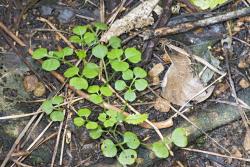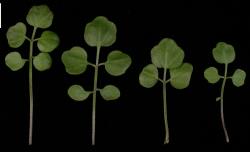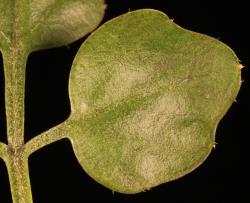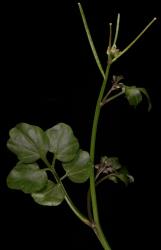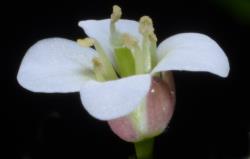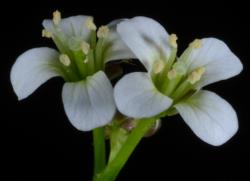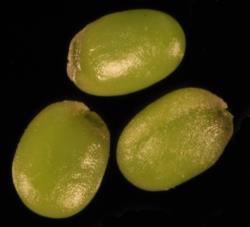Perennial herb, single rosette or with short lateral branches, stem and branches 0.8–1.4 mm diam. Leaves up to 130 mm long, pinnatisect; lamina 20.0–60.0 × 10.0–50.0 mm, green to dark green, usually semi-coriaceous, glabrous on abaxial surface, glabrous or sometimes sparsely hairy on adaxial surface, margin and petiole glabrous or sparsely hairy; hydathodes on leaflet margin, conspicuous. Terminal pinna 6.0–21.0 × 7.0–25.0 mm, simple, usually with 1–2 shallow lobes, orbicular-reniform to orbicular-rhomboid, apex obtuse and usually with a conspicuous hydathode, base weakly cordate to truncate. Lateral pinnae 2–4(–6), 3.0–20.0 × 3.0–22.0, orbicular-reniform, orbicular-rhomboid, to broadly elliptic, usually with 1–2 shallow lobes, base often oblique, petiolule 1.0–11.0 mm long; petiole up to 80.0 mm long; hairs up to 0.4 mm long. Cauline leaves similar to rosette leaves but smaller and with fewer lateral pinnae, leaflet lobes becoming more triangular. Inflorescence racemose, with lateral racemes, each raceme 10–13-flowered; peduncle up to 250 mm long, 1.0–3.0 mm diam. at base, upright, glabrous. Pedicels 2.0–15.0 mm long, 0.4–1.0 mm diam., quadrangular, glabrous, ascending, spreading or curved downward. Sepals 2.2–3.0 × 1.2–1.6 mm, elliptic-oblong to elliptic, saccate, green or red-brown, glabrous or sparsely hairy distally, margin white and membranous, apex obtuse, base truncate. Petals 4.5–6.0 × 2.1–3.0 mm, white, limb obovate to broadly elliptic; apex obtuse; base cuneate, tapering to a 0.5–1.2 mm long claw; sometimes apetalous. Stamens 6; median filaments 4, 2.7–2.9 mm long; lateral filaments 2, 2.0–2.7 mm long; anthers 0.4–0.5 mm long, cream to pale yellow, when dehiscent held at a similar height to or slightly below the stigma. Ovary 2.7–3.7 mm long, 0.4–0.5 mm diam., ± terete, green, glabrous; ovules 22–28; style 0.1–0.2 mm long, ± terete; stigma 0.6–0.7 mm diam. Siliques 21.0–35.0 × 1.1–1.5 mm, glabrous, style 0.7–1.2 mm long; valves green at maturity and when dehiscent, replum 0.3–0.4 mm wide. Seeds 1.2–1.8 mm long, 0.8–1.0 mm wide, 0.4–0.5 mm thick, oblong to broadly oblong, green to light brown-green; wing absent.
North Island: Auckland, Volcanic Plateau, Taranaki, Gisborne, Southern North Island.
South Island: Western Nelson, Westland, Marlborough.
Stewart Island.
Cardamine chlorina usually grows on moist or wet ground in swampy areas, seepages, flushes and damp depressions along track edges, on stream and river banks and adjacent terraces, riverbeds and cliffs, in sinkholes, among tussockland, scrub and forest.
Cardamine chlorina is assessed as having a conservation status of Not Threatened (de Lange et al. 2018).
Flowering September–March; Fruiting November–March.



